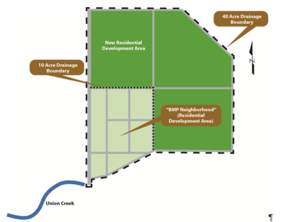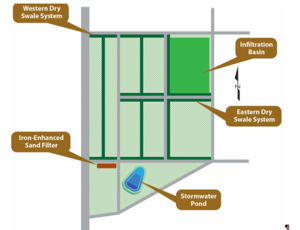
Scenario for developing a stormwater treatment train for constructed ponds in new development Revision as of 21:44, 14 July 2015 by PLeegar (talk | contribs) (→Step 4.1: Varied BMP Approach BMP Selection)
Contents
- 1 Treatment Train Scenarios
- 1.1 New Development & Stormwater Ponds in Series Scenarios
- 1.1.1 Step 1: Review Project Goals & Site Conditions
- 1.1.2 Step 2: Review Pollutant Removal Processes & Identify Potential Practices
- 1.1.3 Step 3: Determine Site Constraints & BMP Placement
- 1.1.4 Step 4 Select Individual BMPs & Evaluate Range of Performance
- 1.1.5 Step 4.1: Varied BMP Approach BMP Selection
- 1.1.6 Step 4.2: Stormwater Ponds in Series Approach BMP Selection
- 1.1 New Development & Stormwater Ponds in Series Scenarios
Treatment Train Scenarios
New Development & Stormwater Ponds in Series Scenarios
Step 1: Review Project Goals & Site Conditions
This scenario is for a new residential development in the rural town in central Minnesota. The new development is to be 40 acres with four 10-acre sub-neighborhoods. The upstream neighborhoods have slopes of 2% draining to the downstream southwest neighborhood, hereby referred to as the “BMP Neighborhood.” The basic site conditions for the New Development setting are summarized in Table 3.5.1. For this scenario two treatment train options will be evaluated: a Varied BMP Approach and Stormwater Ponds in Series Approach. The existing site layout for the New Development scenario can be seen in the New Residential Development Scenario Base schematic.
At the southwest corner of the BMP Neighborhood is an outlet to Union Creek, which continues southwest to a small lake. This lake is known to be nutrient impaired with excess levels of phosphorous possibly due to fertilizer use from upstream lawns, gardens and agricultural areas. The use of fertilizers is not uncommon and often necessary as sandy soils are generally not productive for vegetation growth. Interception of nutrients through BMPs before entering the stream system is a preferable method of pollutant reduction for this project. The New Development Scenario Existing Site Condition table below describes the site conditions for this new development.
New Development Scenario Existing Site Conditions
Step 2: Review Pollutant Removal Processes & Identify Potential Practices
The BMPs selected for the New Development site need to achieve the goals of decreased runoff volume or peak flow rate attenuation and pollutant removal, as well as fit within the site constraints. The New Development Scenario BMP Practice Selection table below discusses the applicability of BMP practices to this site.
New Development Scenario BMP Practice Selection
Infiltrator, filter, swales & strips, and constructed basin BMPs are determined to best address the goals of this project for the New Development scenario. The process of selecting and placing BMPs on a site is typically iterative, working between the site constraints, project goals, and available budget. The approach and considerations for this scenario are discussed in the following sections.
Step 3: Determine Site Constraints & BMP Placement
The New Development site constraints will influence successful BMP integration within this residential community. These constraints must be considered with BMP selection and design. Some specific site constraints for this scenario in the new residential development area include:
- Available Space –The existing road configuration should remain to avoid additional unnecessary costs of redesigning and reconstructing roads. Selected BMPs must fit within the already existing pervious areas.
- Public Integration – New development settings are usually characterized by residential neighborhoods with high interaction between the public and their environment. Selected BMPs should add to the aesthetic value of the neighborhood and be safe for interaction with all ages.
- Utilities –Utilities will have to be constructed or adjusted to meet the requirements of a new residential area. BMP sizing and location should try to avoid major conflict with existing or planned utilities.
- Regulatory Requirements - All local, state, and federal regulatory requirements must be met. The design criteria and recommendations from the Minnesota Stormwater Manual will be followed.
To meet space allotments, allow for maximum volume and pollutant removal via a centralized collection point, and to promote community recreation, the most viable locations for the BMPs are within the southwesterly quadrant of the neighborhood which is closest to Union Creek, as shown in the New Residential Development Scenario Base schematic. The BMPs should be designed to fit within the already pervious areas to prevent construction to the existing roads. Further considerations for placement of BMPs are the required minimum dimensions for rural residential roads, curbs, sidewalks and right-of-way zones as well as minimum setback requirements.
Step 4 Select Individual BMPs & Evaluate Range of Performance
Step 2 introduced the practices that would best address the goals and site constraints for the New Development scenario as infiltrators, filters, swales & strips, and constructed basin BMPs. Various BMPs may be considered for a New Development setting where the goals of stormwater management are the reduction of runoff volumes and pollutant loads. However, for the New Development setting the efficacy of two treatment train options were evaluated. The first was a traditional Varied BMP Approach and the second was Stormwater Ponds in Series Approach. The selected BMPs are discussed in the following sections.
Step 4.1: Varied BMP Approach BMP Selection
The following BMPs were evaluated as plausible treatment train options for the Varied BMP Approach in the New Development setting.
Infiltrator: Infiltration Basin
- An infiltration basin allows for a pervious open area that could provide both infiltration and attenuation of stormwater runoff. The basin can incorporate grass vegetation to provide an open activity space for the community during dry weather periods. This will be placed in the northeast corner of the BMP neighborhood allowing for capture of stormwater from the upstream 30 acre residential drainage area. This location is ideal because its size is large enough to provide significant stormwater capture as well as room for recreation.
Filter: Dry Swale System
- Vegetated Filters such as dry swales can replace conventional storm sewers to provide a greener and more aesthetic corridor for the neighborhood. The dry swales will be used as a pathway to transport water from the upstream end of the BMP Neighborhood to the downstream BMPs near the outlet at Union Creek. In the process the dry swales can remove water pollutants by filtering water through the filter bed media as well as provide pretreatment to downstream BMPs. Media mixes with the highest organic matter content provide the most pollutant removal. Excess water will be transported through an underdrain suspended in a gravel layer below the filter bed media.
Filter: Iron-Enhanced Sand Filter (Minnesota Filter)
- This rural region of Minnesota is characterized by agricultural land use, and likely high inputs of fertilizer. The lake at the discharge point of Union Creek is known to be impaired with high nutrient loading. An iron-enhanced sand filter located upstream of the outlet to Union Creek is proposed to maximize the removal of dissolved phosphorus. An iron enhanced sand filter has median TSS removal rates of 85%, and TP removal rates of 77%. It is also effective at removing Nitrogen, metals, bacteria, and other pollutants.
Constructed Basin: Stormwater Pond
- Constructed stormwater pond in the southwest corner of the BMP Neighborhood allows for final capture and treatment of stormwater New Development area. Although a stormwater pond does not contribute to overall volume reduction it allows for volume control to the downstream creek through peak attenuation. Water may be retained in the stormwater pond first and then released through an appropriately sized outlet. The stormwater pond will be designed to meet Level 3 requirements for maximum Total Suspended Solids and Total Phosphorous removal. Stormwater ponds can expect pollutant removal for TSS of 84% and a TP removal of 50%.
The selected BMPs for the Varied BMP Approach include an infiltration basin, a dry swale conveyance system, an iron-enhanced sand filter, and a stormwater pond. The Development Scenario Varied BMP Approach BMP Layout schematic below displays the proposed BMP treatment train layout for the Varied BMP Approach of the New Development Scenario.
Step 4.2: Stormwater Ponds in Series Approach BMP Selection
The Stormwater Ponds in Series Approach maintains the downstream stormwater pond, however an upstream larger stormwater pond replaces the other BMPs at the location of the former infiltration basin, as depicted in Figure 3.5.3. This stormwater pond is also designed to meet the Level 3 requirements for maximum TSS and TP removal. Although stormwater ponds do not contribute to reduction of runoff volume, they allow for water retention and controlled water release. Volume control prevents unwanted ponding by capturing water in the constructed ponds and releasing it at a rate such that the capacity of the natural soils, vegetation, and downstream waterbody is not overwhelmed in a storm event.
A cost-benefit evaluation of implementing two vs. three stormwater ponds in series was completed. It was determined that two ponds would require less initial capital and future operations and maintenance costs. The MIDS calculator also showed that two ponds would perform to a standard exceeding that of three ponds for TSS and TP removal

